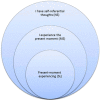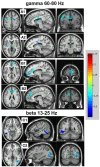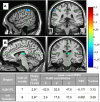Mindfulness-induced selflessness: a MEG neurophenomenological study - PubMed (original) (raw)
Mindfulness-induced selflessness: a MEG neurophenomenological study
Yair Dor-Ziderman et al. Front Hum Neurosci. 2013.
Abstract
Contemporary philosophical and neurocognitive studies of the self have dissociated two distinct types of self-awareness: a "narrative" self-awareness (NS) weaving together episodic memory, future planning and self-evaluation into a coherent self-narrative and identity, and a "minimal" self-awareness (MS) focused on present momentary experience and closely tied to the sense of agency and ownership. Long-term Buddhist meditation practice aims at realization of a "selfless" mode of awareness (SL), where identification with a static sense of self is replaced by identification with the phenomenon of experiencing itself. NS-mediating mechanisms have been explored by neuroimaging, mainly fMRI, implicating prefrontal midline structures, but MS processes are not well characterized and SL even less so. To this end we tested 12 long-term mindfulness meditators using a neurophenomenological study design, incorporating both magnetoencephalogram (MEG) recordings and first person descriptions. We found that (1) NS attenuation involves extensive frontal, and medial prefrontal gamma band (60-80 Hz) power decreases, consistent with fMRI and intracranial EEG findings; (2) MS attenuation is related to beta-band (13-25 Hz) power decreases in a network that includes ventral medial prefrontal, medial posterior and lateral parietal regions; and (3) the experience of selflessness is linked to attenuation of beta-band activity in the right inferior parietal lobule. These results highlight the role of dissociable frequency-dependent networks in supporting different modes of self-processing, and the utility of combining phenomenology, mindfulness training and electrophysiological neuroimaging for characterizing self-awareness.
Keywords: MEG; beta frequency band; mindfulness meditation; minimal self; narrative self; neurophenomenology; right inferior parietal lobule; self-awareness.
Figures
Figure 1
Working model of self-awareness modes. NS, MS and SL as encapsulated processing modes.
Figure 2
Emotional content during NS, MS, and SL. Distribution of emotional content among participants (_x_-axis) during NS, MS, and SL (_y_-axis). Note the marked difference between NS and other 2 conditions regarding negative and mixed vs. neutral emotions.
Figure 3
2D scalp maps of frequency bands with significant power PSC. 2D topographic representations of significant sensor-level power PSC for the NS vs. MS high-gamma 60–80 Hz (left), and MS vs. SL beta 13–25 Hz (right). Dots on the map represent sensors; color bar scale indicates PSC from 0.2 (dark red) to −0.2 (dark blue).
Figure 4
NS vs. MS beamforming source estimates in the gamma (60–80 Hz) and beta (13–25 Hz) frequency bands. Axial, sagittal, and coronal views (left to right) of group (n = 12) PSC source estimates overlayed on the Colin template. Note that in all images right and left sides are crossed. Color bar indicates PSC degree. Gamma band clusters: Cluster A is presented in 2 views. Crosshairs in (A1) are on the right medial anterior cingulate, and in (A2) on the left thalamus. Cluster B is presented in 2 views. Crosshairs in (B1) are on the left anterior cingulate, and in (B2) on the right anterior medial prefrontal cortex. Beta band clusters: Crosshairs in (C1) are on the right fusiform gyrus, and in (C2) on the left middle occipital gyrus.
Figure 5
MS vs. SL beamforming source estimates in the beta (13–25 Hz) band. Axial, sagittal, and coronal views (left to right) of group (N = 12) SAM pseudo-F source estimates overlayed on the Colin template. Note that in all images right and left sides are crossed. Color bar indicates PSC degree. Cluster A reveals prefrontal deactivations in two views: the crosshairs in (A1) are on the left anterior medial prefrontal gyrus, and in (A2) on the right subgenual anterior cingulate. Cluster (B) shows deactivation in the posterior medial cortex, with the crosshairs pinpointing the right precuneus. Cluster (C) shows deactivation in the left thalamus; and clusters (D) and (E) deactivations in the right and left inferior parietal lobules, respectively.
Figure 6
Phenomenological categories and meditative expertise chart. Participants (_x_-axis) are plotted as a function of meditative expertise (_y_-axis) from least to most -experienced. The meditation experience measure is a normalized (0–1) measure incorporating both years and hours of meditation practice. Colors indicate phenomenological category of participants' SL description (blue = LO [Lack-of-ownership], green = AE [Altered-experience], yellow = LH [Less-happening], white = unclear). Note the increase in meditative expertise for the LO group (circled in red).
Figure 7
LO source estimates. Sagittal and coronal views of significant (*p < 0.02, corrected) LO source estimates (n = 4) relative to the other participants (n = 6, not including “unclear” category), overlayed on the Colin template. Crosshairs are in (A) on the right IPL; and in (B) on the left dorsomedial thalamus. The table provides Talairach coordinates, PSC, and other cluster details.
Similar articles
- Self-specific processing in the meditating brain: a MEG neurophenomenology study.
Dor-Ziderman Y, Ataria Y, Fulder S, Goldstein A, Berkovich-Ohana A. Dor-Ziderman Y, et al. Neurosci Conscious. 2016 Jan;2016(1):niw019. doi: 10.1093/nc/niw019. Epub 2016 Oct 10. Neurosci Conscious. 2016. PMID: 30397512 Free PMC article. - Alterations in the sense of time, space, and body in the mindfulness-trained brain: a neurophenomenologically-guided MEG study.
Berkovich-Ohana A, Dor-Ziderman Y, Glicksohn J, Goldstein A. Berkovich-Ohana A, et al. Front Psychol. 2013 Dec 3;4:912. doi: 10.3389/fpsyg.2013.00912. eCollection 2013. Front Psychol. 2013. PMID: 24348455 Free PMC article. - Impact of meditation training on the default mode network during a restful state.
Taylor VA, Daneault V, Grant J, Scavone G, Breton E, Roffe-Vidal S, Courtemanche J, Lavarenne AS, Marrelec G, Benali H, Beauregard M. Taylor VA, et al. Soc Cogn Affect Neurosci. 2013 Jan;8(1):4-14. doi: 10.1093/scan/nsr087. Epub 2012 Mar 24. Soc Cogn Affect Neurosci. 2013. PMID: 22446298 Free PMC article. - Mindfulness in the focus of the neurosciences - The contribution of neuroimaging to the understanding of mindfulness.
Weder BJ. Weder BJ. Front Behav Neurosci. 2022 Oct 17;16:928522. doi: 10.3389/fnbeh.2022.928522. eCollection 2022. Front Behav Neurosci. 2022. PMID: 36325155 Free PMC article. - An Overview of Neurophenomenological Approaches to Meditation and Their Relevance to Clinical Research.
Lutz A, Abdoun O, Dor-Ziderman Y, Trautwein FM, Berkovich-Ohana A. Lutz A, et al. Biol Psychiatry Cogn Neurosci Neuroimaging. 2025 Apr;10(4):411-424. doi: 10.1016/j.bpsc.2024.11.008. Epub 2024 Nov 22. Biol Psychiatry Cogn Neurosci Neuroimaging. 2025. PMID: 39579982 Review.
Cited by
- The Effects of Mindfulness-Based Stress Reduction on Negative Self-Representations in Social Anxiety Disorder-A Randomized Wait-List Controlled Trial.
He L, Han W, Shi Z. He L, et al. Front Psychiatry. 2021 May 12;12:582333. doi: 10.3389/fpsyt.2021.582333. eCollection 2021. Front Psychiatry. 2021. PMID: 34054590 Free PMC article. - Multimodal neurophenomenology of advanced concentration absorption meditation: An intensively sampled case study of Jhana.
Chowdhury A, Bianciardi M, Chapdelaine E, Riaz OS, Timmermann C, van Lutterveld R, Sparby T, Sacchet MD. Chowdhury A, et al. Neuroimage. 2025 Jan;305:120973. doi: 10.1016/j.neuroimage.2024.120973. Epub 2024 Dec 14. Neuroimage. 2025. PMID: 39681243 Free PMC article. - What it means to be Zen: marked modulations of local and interareal synchronization during open monitoring meditation.
Hauswald A, Übelacker T, Leske S, Weisz N. Hauswald A, et al. Neuroimage. 2015 Mar;108:265-73. doi: 10.1016/j.neuroimage.2014.12.065. Epub 2015 Jan 3. Neuroimage. 2015. PMID: 25562827 Free PMC article. - Selflessness, Depression, and Neuroticism: An Interactionist Perspective on the Effects of Self-Transcendence, Perspective-Taking, and Materialism.
Wegemer CM. Wegemer CM. Front Psychol. 2020 Sep 23;11:523950. doi: 10.3389/fpsyg.2020.523950. eCollection 2020. Front Psychol. 2020. PMID: 33071854 Free PMC article. - Beyond the veil of duality-topographic reorganization model of meditation.
Cooper AC, Ventura B, Northoff G. Cooper AC, et al. Neurosci Conscious. 2022 Oct 11;2022(1):niac013. doi: 10.1093/nc/niac013. eCollection 2022. Neurosci Conscious. 2022. PMID: 36237370 Free PMC article. Review.
References
- Austin J. H. (2000). Consciousness evolves when the self dissolves. J. Conscious. Stud. 7, 209–230
LinkOut - more resources
Full Text Sources
Other Literature Sources
Miscellaneous






